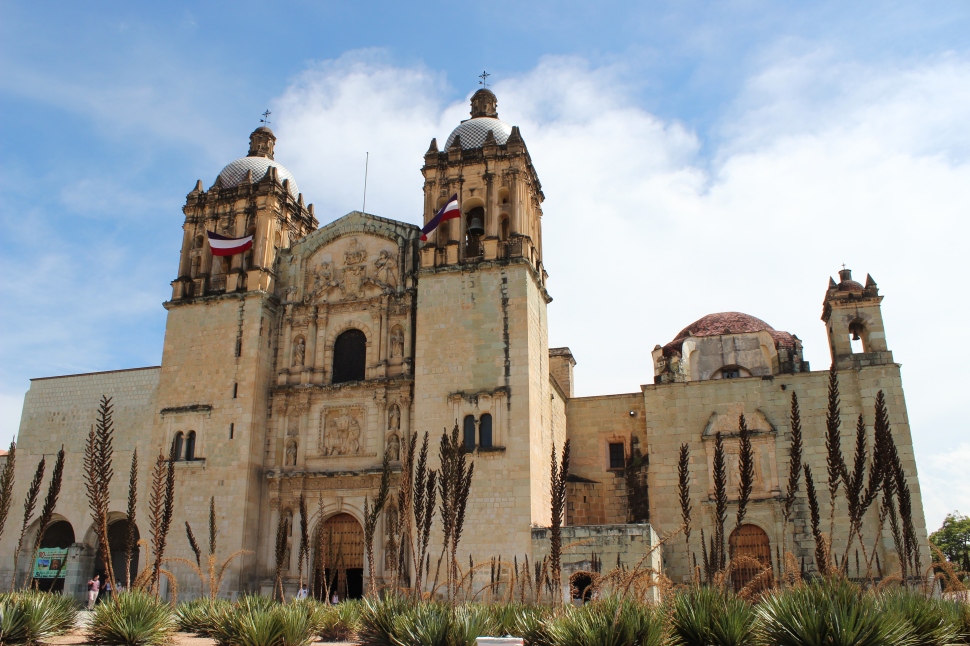What a fabulous time of year to be in Mexico. From the 31st of October to the 2nd of November is when the Dia del Muertos or “Day of the Dead” celebrations are taking place. It is a time for family and friends to get together and honour the deceased by providing offerings of their favourite food and drinks to their final resting place. Oaxaca city in the southwest was just full of energy, there were music filled street parades on every day, markets packed of Oaxacan cuisine, flowers, face painting, fireworks, skeletons and skulls as far as the eye could see. It may seem strange to visit a cemetery at night especially in a town you don’t know a soul, however locals seemed to welcome all visitors to come experience it with them. I went on a tour one night to 3 different cemeteries which all had a different vibe going on. The Panteon general was by far the busiest it even had a street like carnival on outside with side shows and rides. Xoxocotlan (pronounced ho-ho-cotlan) and the small cemetery nearby seemed a little more authentic, each family would decorate the gravesite of their loved ones on a grand scale with marigolds, candles, photographs, offerings of bread and chocolate, they would bring chairs or rugs to sit by them all night eating, drinking mezcal, playing music, it really was beautiful to see
 After appreciating the meaning behind the celebrations, the next night I felt like I wanted to participate a little more and get in on the face painting action. A group of us at my hostel teamed up with some of Amelia’s friends down the road and we had the best time, we actually went walking in one of the street parades with the locals. Who should we see in the crowd of what 10 thousand plus? My Kiwi friends from San Cristobal, such a small world. We all went for a bite to eat and then the night carried onto a bar – I’m not sure why, but I seem to have a knack for attracting the wierdos. An elderly gentlemen who insisted on kissing my hand as part of his introduction, then wouldn’t stop trying to take my photo – now my face was painted as a dead person, but so was everyone else? Ah well, I managed to escape without him trying to tag along. That night I attempted salsa dancing again in a club and while it was a good laugh, it has reconfirmed that I should make no immediate plans to take it up as a career option.
After appreciating the meaning behind the celebrations, the next night I felt like I wanted to participate a little more and get in on the face painting action. A group of us at my hostel teamed up with some of Amelia’s friends down the road and we had the best time, we actually went walking in one of the street parades with the locals. Who should we see in the crowd of what 10 thousand plus? My Kiwi friends from San Cristobal, such a small world. We all went for a bite to eat and then the night carried onto a bar – I’m not sure why, but I seem to have a knack for attracting the wierdos. An elderly gentlemen who insisted on kissing my hand as part of his introduction, then wouldn’t stop trying to take my photo – now my face was painted as a dead person, but so was everyone else? Ah well, I managed to escape without him trying to tag along. That night I attempted salsa dancing again in a club and while it was a good laugh, it has reconfirmed that I should make no immediate plans to take it up as a career option.
Apart from the celebrations going on, there was also a lot to see in Oaxaca it was very much a cultural centre with amazing art galleries and restaurants but 2 things in particular were on my list, the Zapotec ruins of Monte Alban, and sussing out what all this fuss of Mezcal is about. First the ruins.

Only 9km outside of the city was the picturesque ancient village built in 500BC…. give or take, a quick bus ride up with a couple of girls from the hostel and we were there. It was a really wide open space which had a great view over the modern day city below. We wandered around for an hour or so climbing up the very steep steps and reading all about the history of the site. We then came across a Mexican gent in his finest running shorts from the 1980’s who showed us down into one of the tombs there. We were wondering what his agenda was, was he after dinero? No he was actually just a genuinely nice guy who stopped to tell us about who was buried there and why. There was a large ball court in part of the ruins and whilst I could exactly understand his Spanish about how the game worked, he explained only the winners were buried in the grand tombs, this one in particular even contained a child and their pet dog. Very interesting. We headed back into town and had worked up quite the appetite, what better time to try one of the Oaxacan dishes “Tlayuda” its a crunchy flat tortilla topped with bean paste and an assortment of meats, kind of like a Mexican version of a thin and crispy pizza. Yum.
That same afternoon I started looking into where I could do a Mezcal tour as it was famous in the region. Thank you TripAdvisor for rating Alvin as the number 1 here because he was brilliant. I was stretching my backpacker budget to allow for this as it wasn’t cheap, but it was definetly worth it. We set off in a small group of just 3 others and our first stop was a 2 man traditional palenque (basically means Mezcal making facility). We learnt so much about the production process, here is my hopefully not butchered too much attempt to summarise. First the agave plants take 8-10 years to grow before you can even begin harvesting, they are often planted alongside beans and corn so the land can be utilised by the families during that period. When they are ready they are cut down and all the leaves removed the “piná” is then roasted for 3 days – sometimes a week in a pit in the ground. The roasting process is what gives Mescal the smokey flavour, the hull is then broken down and crushed by a horse/donkey pulled cement wheel, or in the larger palenques it is done by machine. After the sweet agave is crushed it is placed into wooden barrels with water to ferment, a layer of the fibrous material is put on top to protect it and will serve as a tool to show when it’s ready. Once fermentation is complete its time to distill. Now depending on the scale of producer this is either done with a clay pot or modern copper still. In both cases the liquid is brought to the boil and condensate cooled at the top for the now alcohol to drain off. Most mezcals are double distilled and if you have heard of a “pechuga” (meaning chicken breast in Spanish) variety this is triple distilled, in the final distillation an actual chicken breast is strung inside the clay pot to smoke and infuse the flavour into the beverage, additional herbs can be added such as cinnamon, cloves – apparently there is even a vegan variety out there for those that way inclined. At this point it’s ready to drink, however for even more variations palenqero’s can choose to age the mezcal in oak barrels or add additional flavours, make creamy variations, endless possibilities. Now I had gone into this fairly naive about what mezcal was so I asked what’s the difference between it and tequila? It simply is that tequila is only made from blue agave, every other species – 47 or 200, I’m not sure the exact answer but here is an article to clear that up http://mezcalphd.com/2013/03/how-many-varieties-of-agave-can-be-used-to-make-mezcal-take-2/ is considered mezcal. There really are so many factors affecting the process similar to wine, where the agave is grown, the weather, the recipe handed down through generations, roasting, blending, hygiene conditions also a little questionable but hey we are in Mexico. All in all a fascinating day out, if you are in the region I highly recommend, I even managed to buy a bottle to sneak into my pack to consume along the way.
Now city life has it advantages, always something happening to see and do, but I was ready for a little chill time by the beach. Into the collective it is, I’m heading to Puerto Escondido.


















